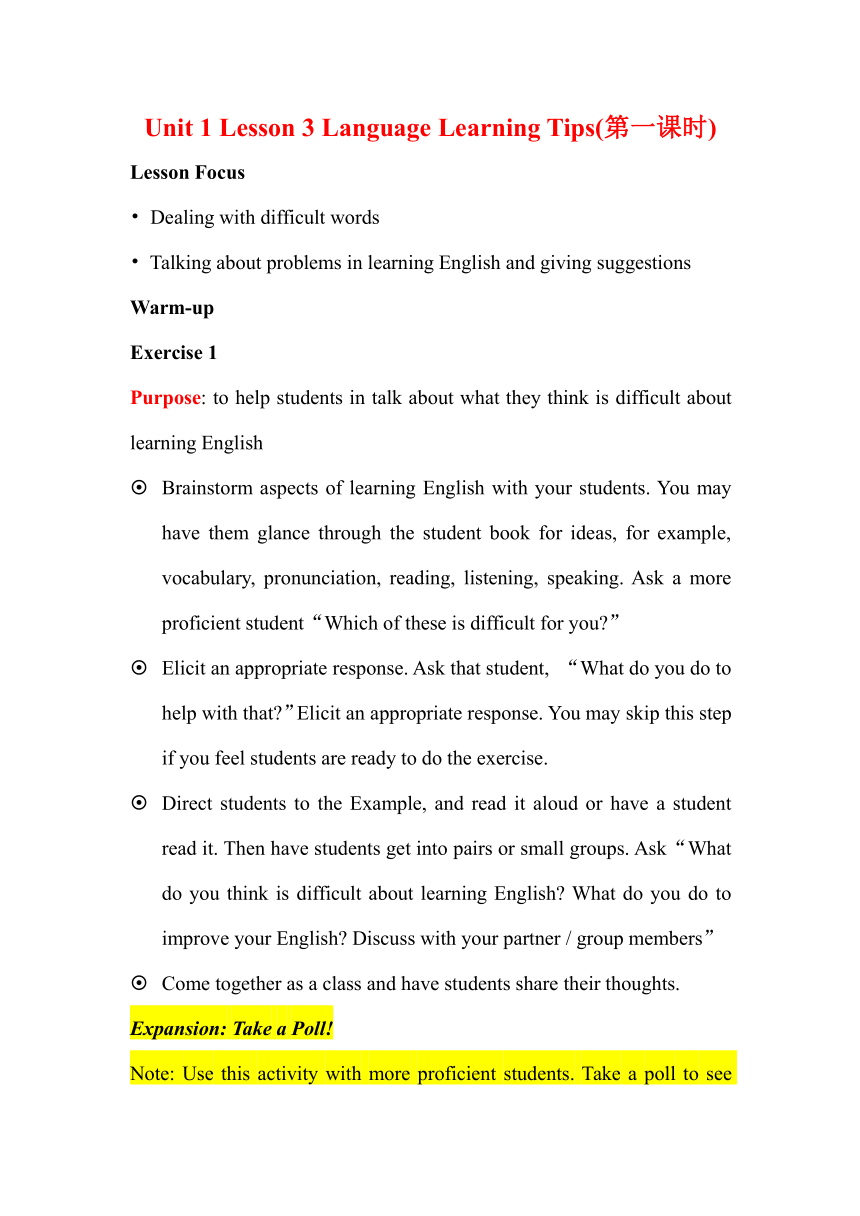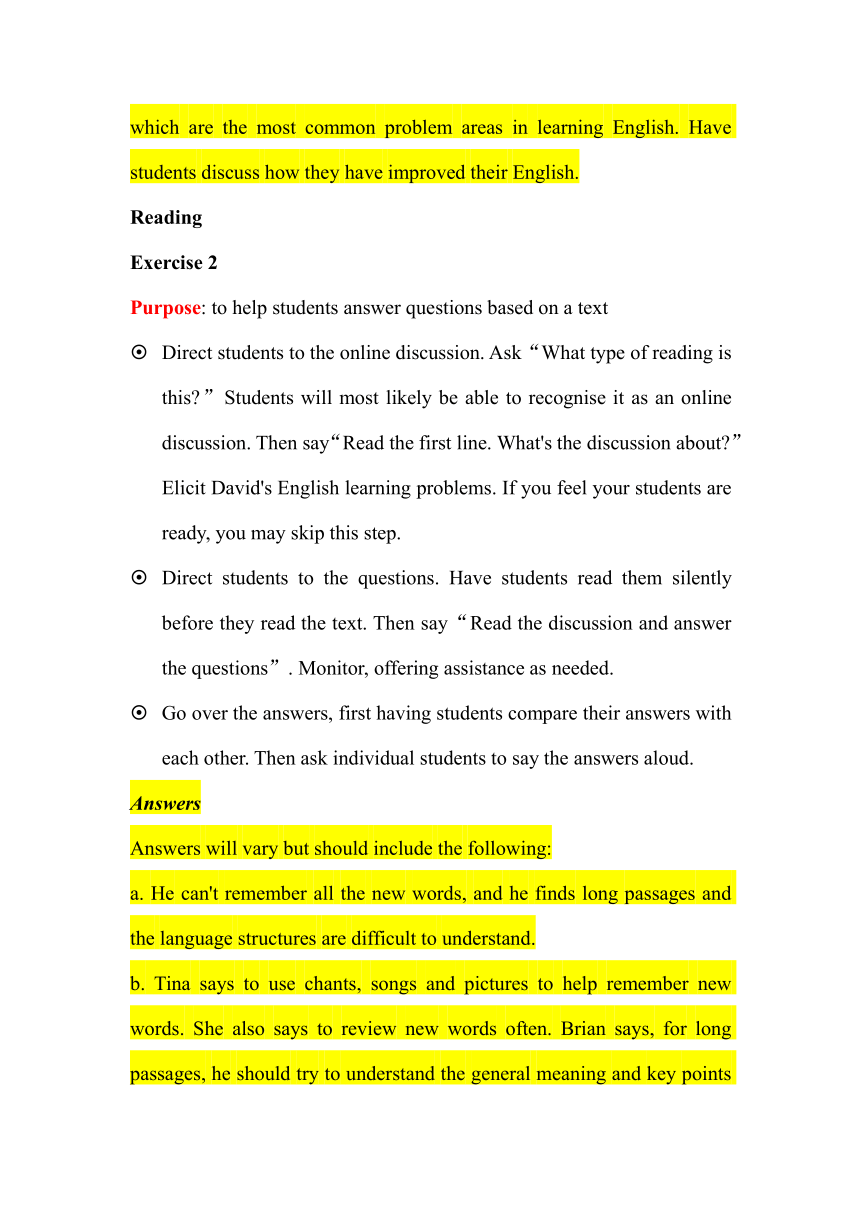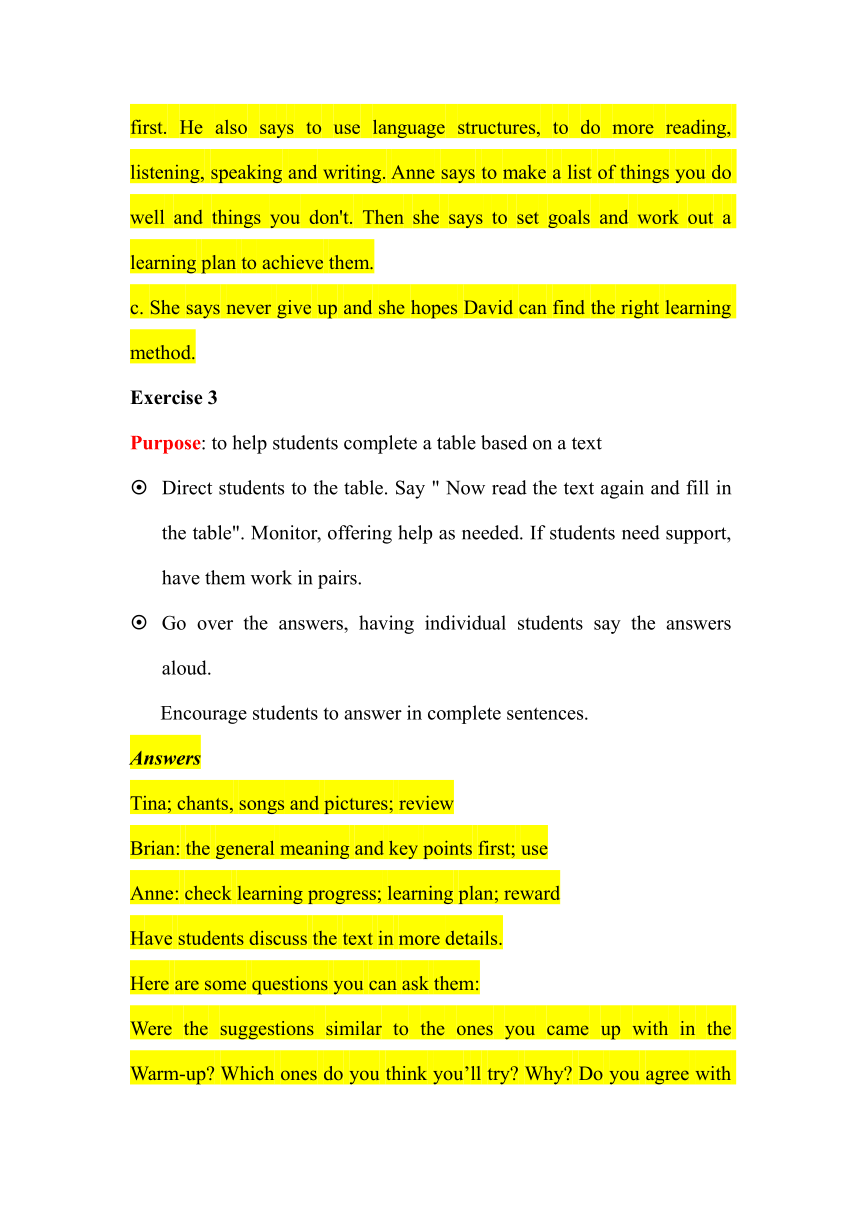Unit 1 Lesson 3 Language Learning Tips 教学设计 2023-2024学年九年级英语北师大版全一册
文档属性
| 名称 | Unit 1 Lesson 3 Language Learning Tips 教学设计 2023-2024学年九年级英语北师大版全一册 |  | |
| 格式 | docx | ||
| 文件大小 | 22.8KB | ||
| 资源类型 | 教案 | ||
| 版本资源 | 北师大版 | ||
| 科目 | 英语 | ||
| 更新时间 | 2023-09-27 21:35:56 | ||
图片预览



文档简介
Unit 1 Lesson 3 Language Learning Tips(第一课时)
Lesson Focus
Dealing with difficult words
Talking about problems in learning English and giving suggestions
Warm-up
Exercise 1
Purpose: to help students in talk about what they think is difficult about learning English
Brainstorm aspects of learning English with your students. You may have them glance through the student book for ideas, for example, vocabulary, pronunciation, reading, listening, speaking. Ask a more proficient student“Which of these is difficult for you ”
Elicit an appropriate response. Ask that student, “What do you do to help with that ”Elicit an appropriate response. You may skip this step if you feel students are ready to do the exercise.
Direct students to the Example, and read it aloud or have a student read it. Then have students get into pairs or small groups. Ask“What do you think is difficult about learning English What do you do to improve your English Discuss with your partner / group members”
Come together as a class and have students share their thoughts.
Expansion: Take a Poll!
Note: Use this activity with more proficient students. Take a poll to see which are the most common problem areas in learning English. Have students discuss how they have improved their English.
Reading
Exercise 2
Purpose: to help students answer questions based on a text
Direct students to the online discussion. Ask“What type of reading is this ”Students will most likely be able to recognise it as an online discussion. Then say“Read the first line. What's the discussion about ”Elicit David's English learning problems. If you feel your students are ready, you may skip this step.
Direct students to the questions. Have students read them silently before they read the text. Then say“Read the discussion and answer the questions”. Monitor, offering assistance as needed.
Go over the answers, first having students compare their answers with each other. Then ask individual students to say the answers aloud.
Answers
Answers will vary but should include the following:
a. He can't remember all the new words, and he finds long passages and the language structures are difficult to understand.
b. Tina says to use chants, songs and pictures to help remember new words. She also says to review new words often. Brian says, for long passages, he should try to understand the general meaning and key points first. He also says to use language structures, to do more reading, listening, speaking and writing. Anne says to make a list of things you do well and things you don't. Then she says to set goals and work out a learning plan to achieve them.
c. She says never give up and she hopes David can find the right learning method.
Exercise 3
Purpose: to help students complete a table based on a text
Direct students to the table. Say " Now read the text again and fill in the table". Monitor, offering help as needed. If students need support, have them work in pairs.
Go over the answers, having individual students say the answers aloud.
Encourage students to answer in complete sentences.
Answers
Tina; chants, songs and pictures; review
Brian: the general meaning and key points first; use
Anne: check learning progress; learning plan; reward
Have students discuss the text in more details.
Here are some questions you can ask them:
Were the suggestions similar to the ones you came up with in the Warm-up Which ones do you think you’ll try Why Do you agree with Mrs Smith Why or why not
Exercise 4
Purpose: to help students choose the correct meaning of words from the text
Ask "Do you ever come across words in a text that are difficult to understand " Elicit an appropriate response. Direct students to the Reading Help box. Say "Read the Reading Help. Do you ever use this strategy " Give them respond to your question.
Direct students to the words. Say " Here are some words from the reading. Find them in the reading. Use the Reading Help to understand their meanings. Then choose the correct meaning of the words". Monitor, guiding your students, as a class or individually, in using the Reading Help. First, have them find the word. Then have them identify the part of speech. Then have them read the con. text and guess the meaning. If students need support, you may have them work in pairs.
Go over the answers, having individual students read them aloud.
Answers
1. b, 2. c, 3. b
Exercise 5
Purpose: to help students discuss their opinions on suggestions for learning English
Ask students to recall the suggestions that Tina, Brian and Anne made. If necessary, direct them to the table in Exercise 3.
Ask "Which suggestion do you think is helpful for you " Have students get into pairs to discuss. Encourage them to explain their o-pinions, using examples of their own language learning experiences. Monitor, offering help as needed.
After students have discussed their opinions, ask "What suggestion would you give to David " Have them discuss with their partners. Monitor, offering help as needed.
After students have finished, come together as a class to discuss. You may wish to take a poll to find out which suggestion students found the most helpful for themselves and which of their suggestions are the most helpful for David.
Exercise 6
Purpose: to help students choose the correct meaning of words from the context
Direct students to the text. Say " Use the Reading Help to figure out the meaning of the underlined words". Have students read the entire text first. Then have them read it again and choose the correct meaning of the words. Monitor, offering help as needed. If students need support, have them work in pairs.
Go over the answers, having individual students read them aloud.
Answers
1. b, 2. a, 3. a, 4.b
Speaking
Exercise 7
Purpose: to help students discuss their English learning problems and give suggestions
Ask "What were David's problems in learning English " Elicit He can't remember all the new words, and long passages and the language structures are difficult to understand. Then ask "Can you remember what suggestions people gave him " Elicit a few from the reading. Ask students if they can remember some of the problems they brainstormed in the Warm-up. Let students speak freely. You may allow them to make a few notes if they need support for the speaking exercise.
Have students get into groups of four. Say "Now discuss your problems in learning English. Give suggestions to each other". Monitor as students talk, offering help as needed.
Come together as a class, having students share their thoughts.
Expansion: Don't Stop!
Note: Use this activity to give students more practice. Have students talk about other subjects they have trouble with. What are their problems and what suggestions can they give each other
If time allows, do Workbook pages 122 and 123 in class. Alternatively, assign for homework.
Lesson Focus
Dealing with difficult words
Talking about problems in learning English and giving suggestions
Warm-up
Exercise 1
Purpose: to help students in talk about what they think is difficult about learning English
Brainstorm aspects of learning English with your students. You may have them glance through the student book for ideas, for example, vocabulary, pronunciation, reading, listening, speaking. Ask a more proficient student“Which of these is difficult for you ”
Elicit an appropriate response. Ask that student, “What do you do to help with that ”Elicit an appropriate response. You may skip this step if you feel students are ready to do the exercise.
Direct students to the Example, and read it aloud or have a student read it. Then have students get into pairs or small groups. Ask“What do you think is difficult about learning English What do you do to improve your English Discuss with your partner / group members”
Come together as a class and have students share their thoughts.
Expansion: Take a Poll!
Note: Use this activity with more proficient students. Take a poll to see which are the most common problem areas in learning English. Have students discuss how they have improved their English.
Reading
Exercise 2
Purpose: to help students answer questions based on a text
Direct students to the online discussion. Ask“What type of reading is this ”Students will most likely be able to recognise it as an online discussion. Then say“Read the first line. What's the discussion about ”Elicit David's English learning problems. If you feel your students are ready, you may skip this step.
Direct students to the questions. Have students read them silently before they read the text. Then say“Read the discussion and answer the questions”. Monitor, offering assistance as needed.
Go over the answers, first having students compare their answers with each other. Then ask individual students to say the answers aloud.
Answers
Answers will vary but should include the following:
a. He can't remember all the new words, and he finds long passages and the language structures are difficult to understand.
b. Tina says to use chants, songs and pictures to help remember new words. She also says to review new words often. Brian says, for long passages, he should try to understand the general meaning and key points first. He also says to use language structures, to do more reading, listening, speaking and writing. Anne says to make a list of things you do well and things you don't. Then she says to set goals and work out a learning plan to achieve them.
c. She says never give up and she hopes David can find the right learning method.
Exercise 3
Purpose: to help students complete a table based on a text
Direct students to the table. Say " Now read the text again and fill in the table". Monitor, offering help as needed. If students need support, have them work in pairs.
Go over the answers, having individual students say the answers aloud.
Encourage students to answer in complete sentences.
Answers
Tina; chants, songs and pictures; review
Brian: the general meaning and key points first; use
Anne: check learning progress; learning plan; reward
Have students discuss the text in more details.
Here are some questions you can ask them:
Were the suggestions similar to the ones you came up with in the Warm-up Which ones do you think you’ll try Why Do you agree with Mrs Smith Why or why not
Exercise 4
Purpose: to help students choose the correct meaning of words from the text
Ask "Do you ever come across words in a text that are difficult to understand " Elicit an appropriate response. Direct students to the Reading Help box. Say "Read the Reading Help. Do you ever use this strategy " Give them respond to your question.
Direct students to the words. Say " Here are some words from the reading. Find them in the reading. Use the Reading Help to understand their meanings. Then choose the correct meaning of the words". Monitor, guiding your students, as a class or individually, in using the Reading Help. First, have them find the word. Then have them identify the part of speech. Then have them read the con. text and guess the meaning. If students need support, you may have them work in pairs.
Go over the answers, having individual students read them aloud.
Answers
1. b, 2. c, 3. b
Exercise 5
Purpose: to help students discuss their opinions on suggestions for learning English
Ask students to recall the suggestions that Tina, Brian and Anne made. If necessary, direct them to the table in Exercise 3.
Ask "Which suggestion do you think is helpful for you " Have students get into pairs to discuss. Encourage them to explain their o-pinions, using examples of their own language learning experiences. Monitor, offering help as needed.
After students have discussed their opinions, ask "What suggestion would you give to David " Have them discuss with their partners. Monitor, offering help as needed.
After students have finished, come together as a class to discuss. You may wish to take a poll to find out which suggestion students found the most helpful for themselves and which of their suggestions are the most helpful for David.
Exercise 6
Purpose: to help students choose the correct meaning of words from the context
Direct students to the text. Say " Use the Reading Help to figure out the meaning of the underlined words". Have students read the entire text first. Then have them read it again and choose the correct meaning of the words. Monitor, offering help as needed. If students need support, have them work in pairs.
Go over the answers, having individual students read them aloud.
Answers
1. b, 2. a, 3. a, 4.b
Speaking
Exercise 7
Purpose: to help students discuss their English learning problems and give suggestions
Ask "What were David's problems in learning English " Elicit He can't remember all the new words, and long passages and the language structures are difficult to understand. Then ask "Can you remember what suggestions people gave him " Elicit a few from the reading. Ask students if they can remember some of the problems they brainstormed in the Warm-up. Let students speak freely. You may allow them to make a few notes if they need support for the speaking exercise.
Have students get into groups of four. Say "Now discuss your problems in learning English. Give suggestions to each other". Monitor as students talk, offering help as needed.
Come together as a class, having students share their thoughts.
Expansion: Don't Stop!
Note: Use this activity to give students more practice. Have students talk about other subjects they have trouble with. What are their problems and what suggestions can they give each other
If time allows, do Workbook pages 122 and 123 in class. Alternatively, assign for homework.
同课章节目录
- Unit 1 Language
- Lesson 1 Body Language
- Lesson 2 Different Kinds of Language
- Lesson 3 Language Learning Tips
- Communication Workshop
- Unit 2 Books
- Lesson 4 Classics
- Lesson 5 The Book Club
- Lesson 6 Tom Sawye
- Communication Workshop
- Unit 3 Creativity
- Lesson 7 A Famous Invento
- Lesson 8 Good or Bad?
- Lesson 9 Creative Minds
- Communication Workshop
- Unit 4 Space
- Lesson 10 Life in Space
- Lesson 11 The Amazing Shenzhou
- Lesson 12 The Spaceship
- Communication Workshop
- Unit 5 Literature
- Lesson 13 Anne of Green Gables
- Lesson 14 The Dark Room
- Lesson 15 A Famous Write
- Communication Workshop
- Unit 6 Role Models
- Lesson 16 Yao Ming
- Lesson 17 People in Our Lives
- Lesson 18 Steve Jobs
- Communication Workshop
- Unit 7 Journeys
- Lesson 19 The Silk Road
- Lesson 20 Life in a Journey
- Lesson 21 To the South Pole
- Communication Workshop
- Unit 8 Discoveries
- Lesson 22 Famous Discoveries
- Lesson 23 Discovery of the Yea
- Lesson 24 An Experiment Report
- Communication Workshop
- Unit 9 Save the Planet
- Lesson 25 Going Green
- Lesson 26 Our Rive
- Lesson 27 Tree Heroes
- Communication Workshop
